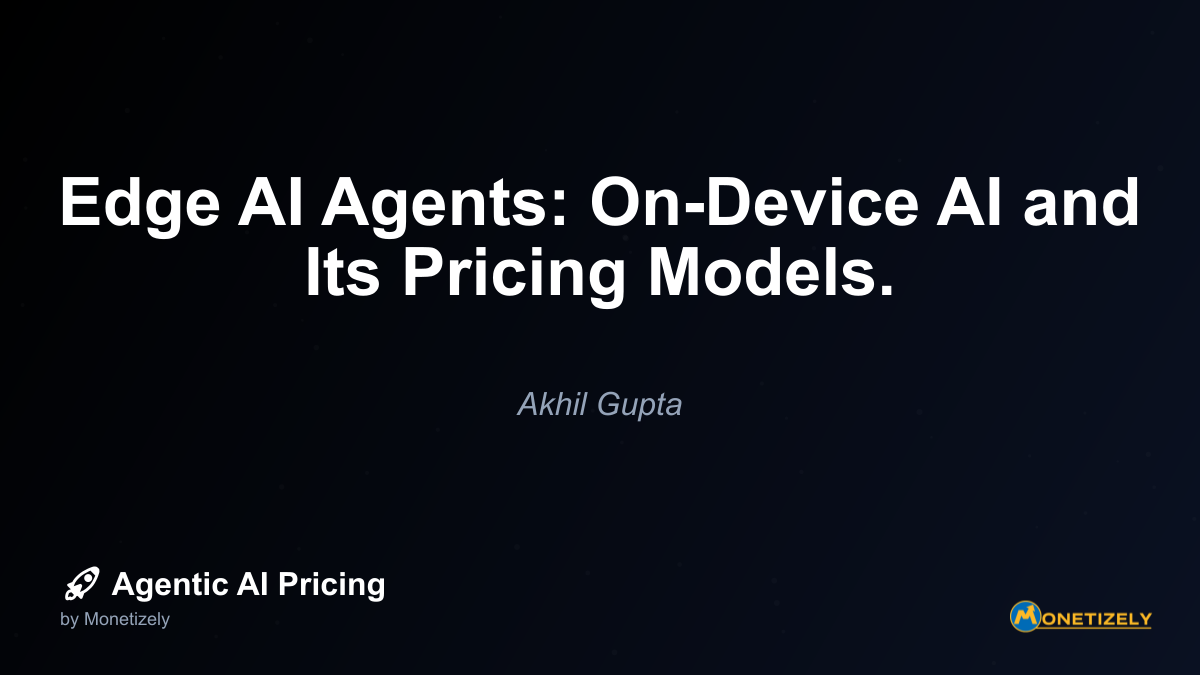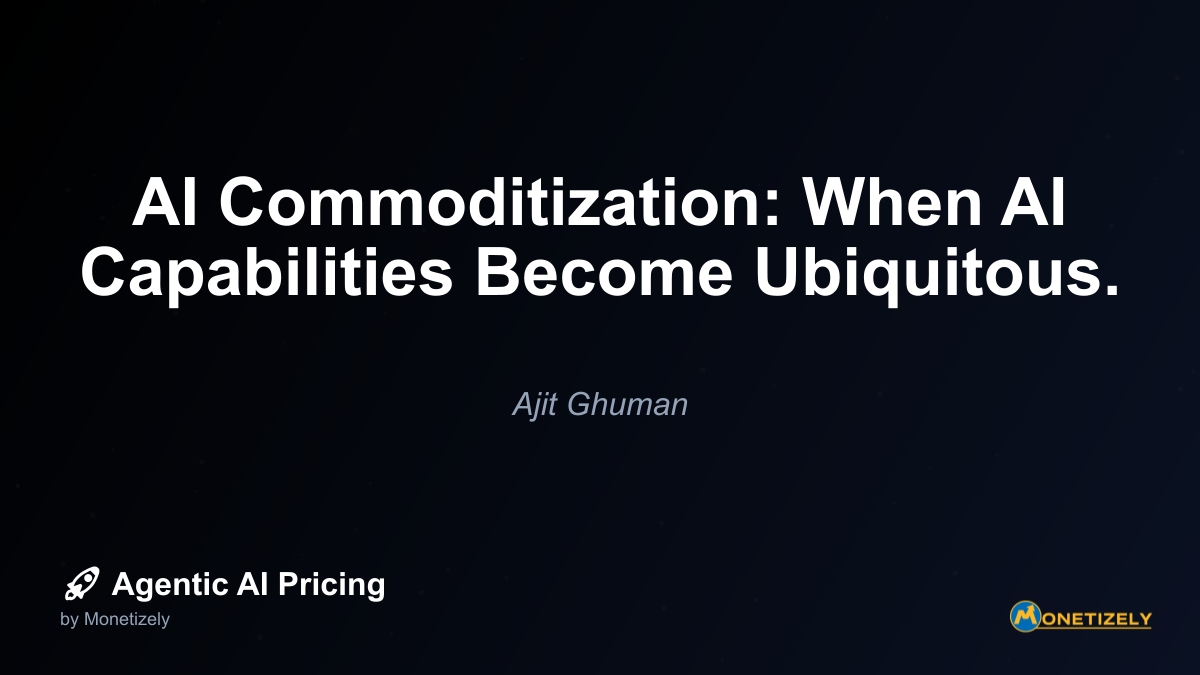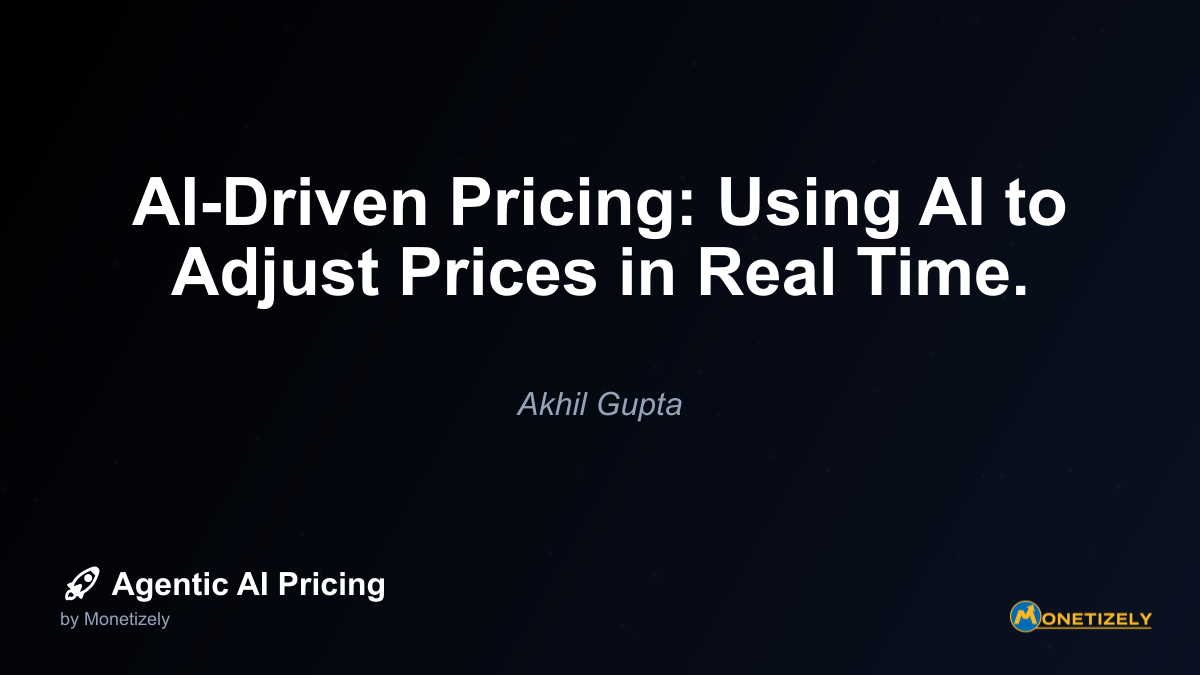· Akhil Gupta · Emerging Trends · 7 min read
Edge AI Agents: On-Device AI and Its Pricing Models.
AI and SaaS Pricing Masterclass
Learn the art of strategic pricing directly from industry experts. Our comprehensive course provides frameworks and methodologies for optimizing your pricing strategy in the evolving AI landscape. Earn a professional certification that can be imported directly to your LinkedIn profile.

Implementation Challenges for Edge AI Pricing
While the theoretical models for edge AI pricing are evolving rapidly, practical implementation presents several challenges:
License Management and Enforcement
Enforcing licensing terms across distributed, occasionally-connected devices requires sophisticated approaches:
- Secure hardware elements: Trusted Platform Modules (TPMs) or secure enclaves can store and verify license credentials
- Periodic validation: Devices can require periodic connectivity to validate licenses
- Grace periods: Implementing reasonable timeframes where devices continue functioning without validation
- Degradation approaches: Gradually reducing functionality rather than immediate shutdowns when licenses expire
Organizations must balance security with user experience, as overly restrictive enforcement can damage customer relationships.
Usage Metering and Analytics
For usage-based or tiered models, accurately measuring utilization presents challenges:
- Local metering: Devices must reliably track their own usage
- Data synchronization: Usage data must be efficiently transmitted when connectivity is available
- Audit mechanisms: Systems should detect and prevent tampering with usage metrics
- Privacy considerations: Usage tracking must respect user privacy expectations and regulatory requirements
These technical challenges often push companies toward simpler licensing models that don’t require granular usage tracking.
Pricing Communication and Transparency
The complexity of edge AI deployment can make pricing difficult for customers to understand:
- Total cost of ownership: Helping customers understand all costs (hardware, software, maintenance)
- Value metrics: Clearly communicating how pricing relates to delivered value
- Comparison frameworks: Enabling meaningful comparisons with alternative approaches
- ROI calculators: Tools that demonstrate expected returns based on customer-specific variables
Transparent pricing communication becomes a competitive differentiator in this complex landscape.
Upgrade and Maintenance Pathways
Edge AI solutions must address how improvements and updates are delivered and monetized:
- Model updates: How are improved AI models delivered and charged for?
- Feature expansion: What happens when new capabilities become available?
- Hardware obsolescence: How is the transition to new hardware handled?
- End-of-life policies: What support is provided for legacy deployments?
These considerations should be built into pricing models from the beginning rather than addressed reactively.
Industry-Specific Edge AI Pricing Trends
Different industries are adopting distinct approaches to edge AI pricing based on their unique characteristics:
Consumer Electronics
Consumer markets show several distinctive patterns:
- Feature bundling: AI capabilities bundled into premium device tiers
- Ecosystem value: Edge AI enhancing value of broader product ecosystems
- Freemium approaches: Basic capabilities included with premium features requiring subscription
- Privacy as value proposition: On-device processing marketed as privacy advantage
Example: Smart home device manufacturers increasingly include basic voice recognition capabilities in the purchase price while offering premium voice assistant features through subscription services.
Industrial and Manufacturing
Industrial applications emphasize ROI and operational improvements:
- Outcome guarantees: Pricing tied to specific operational improvements
- Equipment lifetime value: AI capabilities priced as percentage of protected asset value
- Retrofit economics: Pricing models for adding AI to existing equipment
- Risk-sharing approaches: Vendors participating in both costs and benefits
Example: Predictive maintenance providers charging based on a combination of equipment value protected and demonstrated reduction in downtime.
Healthcare and Medical Devices
Healthcare applications balance innovation with regulatory compliance:
- Regulatory-aligned models: Pricing reflecting certification and compliance costs
- Procedure-based pricing: Fees per diagnostic procedure or treatment
- Outcome-based approaches: Payments tied to patient outcomes
- Reimbursement-aligned pricing: Structures designed to work with insurance and reimbursement systems
Example: Medical imaging devices with embedded diagnostic AI charging per scan with tiered pricing based on complexity of analysis.
Automotive and Transportation
Mobility applications are pioneering new approaches:
- Feature activation: One-time or subscription fees to activate capabilities
- Usage-based models: Pricing based on miles driven or hours of operation
- Safety premium: Value-based pricing for safety-enhancing features
- Data monetization: Reduced hardware costs offset by data sharing agreements
Example: Autonomous vehicle features available through subscription or one-time purchase after vehicle acquisition.
The Future of Edge AI Pricing: Emerging Trends
As edge AI continues to mature, several pricing trends are emerging that will shape the next generation of business models:
Federated Intelligence Pricing
As federated learning enables AI models to improve across distributed devices without centralizing data, new pricing models are emerging:
- Contribution-based discounts: Reduced fees for customers who contribute more to model improvement
- Data dividend models: Sharing revenue with users who enhance model performance
- Collective improvement pricing: Fees adjusted based on community-wide performance gains
These approaches recognize the collaborative nature of distributed intelligence and reward participation in ecosystem improvement.
Sovereign AI and Data Ownership Models
As data sovereignty becomes more important, pricing is evolving to reflect data control:
- Local processing premiums: Higher prices for solutions that keep data local
- Data ownership guarantees: Pricing that includes explicit data rights
- Compliance-specific tiers: Different price points for various regulatory requirements
- Jurisdiction-specific pricing: Rates that vary based on regional data requirements
Organizations increasingly recognize that data control has tangible value that can be reflected in pricing.
Embedded Finance and Edge AI Integration
The integration of financial services with edge AI is creating new pricing possibilities:
- Pay-per-outcome financing: Financial products that fund edge AI based on delivered results
- Equipment-as-a-service: Bundling hardware, AI, and financing into single subscriptions
- Risk-adjusted pricing: Rates that vary based on AI-predicted outcomes
- Dynamic collateralization: Financing terms that adjust based on edge AI performance data
These models reduce adoption barriers by aligning costs with benefits and distributing expenses over time.
Marketplaces and Edge AI App Stores
The emergence of edge AI marketplaces is creating platform-based pricing approaches:
- Revenue sharing: Platform owners taking percentage of application sales
- Developer ecosystems: Pricing that encourages third-party development
- Model marketplaces: Trading trained models with various licensing options
- Component pricing: Purchasing specific AI capabilities to integrate into solutions
These marketplace models will accelerate edge AI adoption by creating standardized pricing frameworks and reducing discovery costs.
Developing Your Edge AI Pricing Strategy
For organizations developing edge AI solutions, a structured approach to pricing strategy is essential:
1. Value Identification and Quantification
Begin by clearly identifying and quantifying the value your edge AI solution delivers:
- What specific problems does it solve?
- What measurable improvements does it create?
- How does it compare to alternatives (including doing nothing)?
- What is the monetary value of these improvements?
This value assessment provides the foundation for all pricing decisions.
2. Customer Segmentation and Willingness-to-Pay Analysis
Different customer segments have varying needs and willingness to pay:
- Which segments derive the most value from your solution?
- How do purchasing processes differ across segments?
- What pricing models align with each segment’s expectations?
- How price-sensitive is each segment?
This segmentation guides both pricing levels and model selection.
3. Competitive Positioning and Differentiation
Understand your position relative to alternatives:
- What competitive alternatives exist (including non-AI approaches)?
- How does your solution differentiate from these alternatives?
- What pricing signals do you want to send about your positioning?
- How will competitors respond to your pricing?
This competitive context helps avoid commoditization and price wars.
4. Cost Structure and Economic Analysis
Develop a clear understanding of your solution’s economics:
- What are the fixed and variable costs of development and deployment?
- How do costs scale with customer count and usage?
- What is the lifetime value of a customer relationship?
- What margins are required for sustainability?
This economic foundation ensures pricing supports business viability.
5. Pricing Model Selection and Optimization
Based on the preceding analysis, select and optimize pricing models:
- Which models best align with your value proposition and customer expectations?
- How will you test and validate pricing approaches?
- What metrics will you use to evaluate pricing effectiveness?
- How will pricing evolve as your solution matures?
This deliberate selection process prevents default pricing decisions that fail to capture value.
Conclusion: Navigating the Edge AI Pricing Frontier
Edge AI represents a fundamental shift in how artificial intelligence is deployed and utilized, moving computational intelligence from centralized clouds to distributed devices. This architectural transformation necessitates equally transformative approaches to pricing and monetization.
As organizations develop edge AI strategies, they must recognize that pricing is not merely a financial decision but a strategic one that signals value, shapes customer behavior, and defines competitive positioning. The most successful edge AI providers will develop pricing models that:
- Align with the value their solutions deliver
- Respect the distributed nature of edge deployment
- Balance upfront and recurring revenue needs
- Create sustainable economics for ongoing innovation
- Adapt to industry-specific requirements and expectations
While the edge AI pricing landscape continues to evolve, organizations that thoughtfully develop pricing strategies based on customer value, competitive positioning, and economic sustainability will be best positioned to capitalize on this transformative technology trend.
For business leaders navigating this complex landscape, the key is to approach edge AI pricing as an ongoing strategic process rather than a one-time decision. By continuously evaluating customer needs, measuring delivered value, and adapting pricing approaches, organizations can build sustainable business models that capture their fair share of the value they create through edge AI innovation.
Co-Founder & COO
Akhil is an Engineering leader with over 16+ years of experience in building, managing and scaling web-scale, high throughput enterprise applications and teams. He has worked with and led technology teams at FabAlley, BuildSupply and Healthians. He is a graduate from Delhi College of Engineering and UC Berkeley certified CTO.
Pricing Strategy Audit
Let our experts analyze your current pricing strategy and identify opportunities for improvement. Our data-driven assessment will help you unlock untapped revenue potential and optimize your AI pricing approach.




